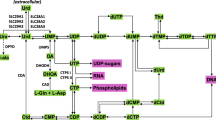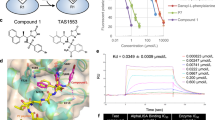Abstract
Trimidox (3,4,5-trihydroxybenzamidoxime), a newly synthesized analog of didox (N,3,4-trihydroxybenzamide) reduced the activity of ribonucleotide reductase (EC 1.17.4.1) in extracts of L1210 cells by 50% (50% growth-inhibitory concentration, IC50) at 5 μM, whereas hydroxyurea, the only ribonucleotide reductase inhibitor in clinical use, exhibited an IC50 of 500 μM. Ribonucleotide reductase activity was also measured in situ by incubating L1210 cells for 24 h with trimidox at 7.5 μM, a concentration that inhibits cell proliferation by 50% (IC50) or at 100 μM for 2 h; these concentrations resulted in a decrease in enzyme activity to 22% and 50% of the control value, respectively. Trimidox and hydroxyurea were cytotoxic to L1210 cells with IC50 values of 7.5 and 50 μM, respectively. Versus ribonucleotide reductase, trimidox and hydroxyurea yielded IC50 values of 12 and 87 μM, respectively. A dose-dependent increase in life span was observed in mice bearing intraperitoneally transplanted L1210 tumors. Trimidox treatment (200 mg/kg; q1dx9) significantly increased the life span of mice bearing L1210 leukemia (by 82 in male mice and 112% in female mice). The antitumor activity appeared more pronounced in female mice than in male mice. Viewed in concert, these findings suggest that trimidox is a new and potent inhibitor of ribonucleotide reductase and that it is a promising candidate for the chemotherapy of cancer in humans.
Similar content being viewed by others
Abbreviations
- Didox:
-
N,3,4-trihydroxybenzamide
- MTT:
-
{3-[4,5-dimethyl-thiazo-2yl]}-2,5-diphenyl tetrazolium bromide
- PBS:
-
phosphate-buffered saline
- trimidox:
-
3,4,5-trihydroxybenzamidoxime HCl
References
Bhalla K, Swerdlow P, Grant S (1981) Effects of thymidine and hydroxyurea on the metabolism and cytotoxicity of 1-β-d-arabinofuranosylcytosine in highly resistant human leukemia cells. Blood 78:2937–2944
Carmichael J, Cantwell BMJ, Mannix KA, Veale D, Elford HL, Blackie R Kerr DJ, Kaye SB, Harris AL (1990) A phase I and pharmacokinetic study of didox: a ribonucleotide reductase inhibitor. Br J Cancer 61:447–450
Carter GL, Cory JG (1988) Cross-resistance patterns in hydroxyurea-resistant leukemia L1210 cells. Cancer Res 48:5796–5799
Cheung AKM, Hoggan MD, Hauswirth WW, Berns KI (1980) Integration of the adeno-associated virus genome into cellular DNA in latently infected human Detroit 6 cells. J Virol 33:739–748
Cory JG (1988) Ribonucleotide reductase as a chemotherapeutic target. Adv Enzyme Regul 27:437–455
Cory JG, Carter GL (1988) Leukemia L1210 cell lines resistant to ribonucleotide inhibitors. Cancer Res 48:839–843
Cory JG, Chiba P (1985) Combination chemotherapy directed at the components of nucleoside diphosphate reductase. Pharmacol Ther 29:111–127
Cory JG, Fleischer AE (1979) Specific inhibitors directed at the individual components of ribonucleotide reductase as an approach to combination chemotherapy. Cancer Res 39:4600–4604
Cory JG, Sato A (1983) Regulation of ribonucleotide reductase activity in mammalian cells. Mol. Cell Biochem 53/54:257–266
Elford HL, Riet B van't (1985) Inhibition of nucleoside diphosphate reductase by hydroxybenzohydroxamic acid derivatives. Pharmacol Ther 29:239–243
Elford HL, Riet B van't (1989) The inhibition of nucleoside diphosphate reductase by hydroxy-benzohydroxamic acid derivatives. In: Cory JG, Cory AH (eds) Inhibitors of ribonucleoside diphosphate reductase activity. International encyclopedia of pharmacology and therapeutics. Pergamon, Oxford, pp 217–233
Elford HL, Freese M, Passamani E, Morris HP (1970) Ribonucleotide reductase and cell proliferation. I. Variations of ribonucleotide reductase activity with tumor growth rate in a series of rat hepatomas. J Biol Chem 245:5228–5233
Elford HL, Wampler GL, Riet B van't (1979) New ribonucleotide reductase inhibitors with antineoplastic activity. Cancer Res 39:844–851
Elford HL, Riet B van't, Wampler GL, Lin AL, Elford RM (1981) Regulation of ribonucleotide reductase in mammalian cells by chemotherapeutic agents. Adv Enzyme Regul 19:151–168
Elford HL, Riet B van't, Wampler GL (1986) Polyhydroxybenzoic acid derivatives. U. S. patent 4623659. United States Patent Office, Washington, D. C.
Fritzer M, Barabas K, Szüts V, Berczi A, Szekeres T, Faulk WP, Goldenberg H (1992) Cytotoxicity of a transferrin-Adriamycin conjugate to anthracycline. Int J Cancer 52:619–623
Moore EC, Hulbert RB (1989) The inhibition of ribonucleoside diphosphate reductase by hydroxyurea, guanazole and pyrrozoloimidazole (IMPY). In: Cory JG, Cory AH (eds) Inhibitors of ribonucleoside diphosphate reductase activity. International encyclopedia of pharmacology and therapeutics. Pergamon, Oxford, pp 165–201
Reichard P, Baldesten A, Rutberg L (1961) Formation of deoxycytidine phosphates from cytidine phosphates in extracts fromEscherichia coli. J Biol Chem 236:1150–1157
Robichaud NJ, Fram RJ (1987) Potentiation of Ara-C induced toxicity by hydroxyurea in LoVo colon carcinoma cells. Biochem Pharmacol 36:1673–1677
Rubens RD, Kaye SB, Soukop M, Williams CJ, Bramton MH, Harris AL (1991) Phase II trial of didox in advanced breast cancer. Br J Cancer 64:1187–1188
Schilsky RL, Williams SF, Ultmann JE, Watson S (1987) Sequential hydroxyurea-cytarabinechemotherapy for refractory non-Hodgkin's lymphoma. J Clin Oncol 5:419–425
Southern E (1975) Detection of specific sequences among DNA fragments separated by gel electrophoresis. J Mol Biol 98:503–518
Takeda E, Weber G (1981) Role of ribonucleotide reductase in expression of the neoplastic program. Life Sci 28:1007–1014
Tihan T, Elford HL, Cory JG (1991) Studies on the mechanisms of inhibition of L1210 cell growth by 3,4-dihydroxybenzohydroxamic acid and 3,4-dihydroxybenzamidoxime. Adv Enzyme Regul 31:71–83
Veale D, Carmichael J, Cantwell BMJ, Elford HL, Blackie R, Kerr DJ, Kaye SB, Harris AL (1988) A phase I pharmacokinetic study of didox administered by 36 hour infusion. Br J Cancer 58:70–73
Walsh CT, Craig RW, Agarwal RP (1980) Increased activation of 1-β-d-arabinofuranosylcytosine by hydroxyurea in L1210 cells. Cancer Res 40:3286–3292
Weber G (1977) Enzymology of cancer cells. N Engl J Med 296:486–493
Author information
Authors and Affiliations
Rights and permissions
About this article
Cite this article
Szekeres, T., Gharehbaghi, K., Fritzer, M. et al. Biochemical and antitumor activity of trimidox, a new inhibitor of ribonucleotide reductase. Cancer Chemother. Pharmacol. 34, 63–66 (1994). https://doi.org/10.1007/BF00686113
Received:
Accepted:
Issue Date:
DOI: https://doi.org/10.1007/BF00686113




